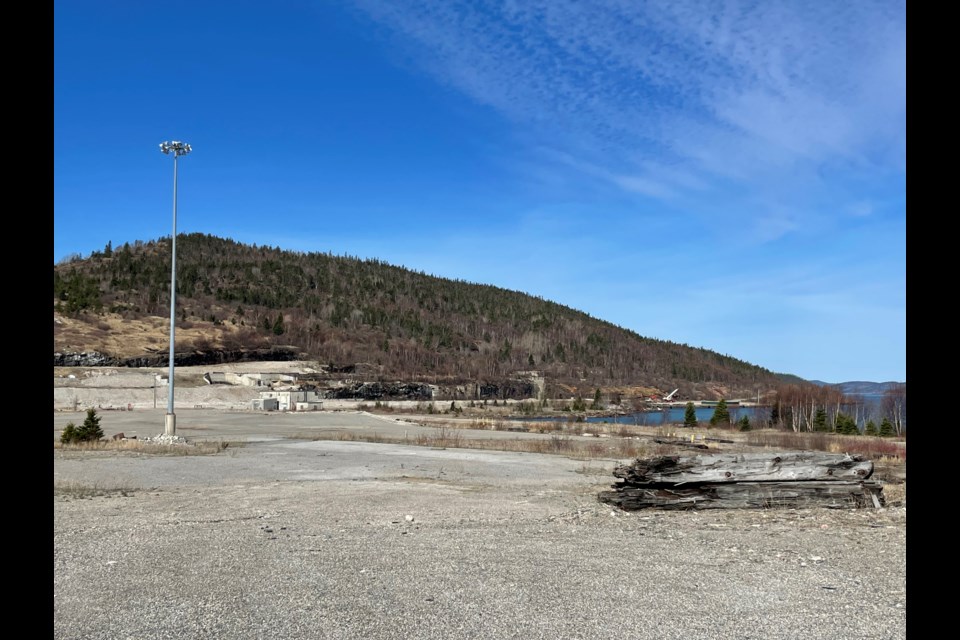MARATHON — A development 14 years in the making could turn Marathon into a strategic shipping and receiving point along the north shore.
Dougall Media spoke to Mayor Rick Dumas about a recent partnership struck between QSL — a Quebec-based company specializing in port terminal operations, stevedoring, marine services, logistics and transport — the town of Marathon, and Biigtigong Nishnaabeg First Nation to revive port operations in Marathon starting this year.
A groundbreaking ceremony was held on March 8, with the new port to be built on the brownfield property where Marathon Pulp previously sat.
“From Sault Ste. Marie to Thunder Bay, there’s no actual commercial port. This dock is in amazing shape for having been built in the 1940s,” Dumas said.
He mentioned a feasibility study was completed on Peninsula Harbour and the town has hired a company out of Sault Ste. Marie to perform some dredging around the wharf in compliance with the study’s findings.
The dredging will ensure the new port can receive ships without any hiccups.
Dumas noted that further dredging may need to be done when it comes to receiving and supplying ships from the European and ocean-going markets, but he said it has only been discussed and is still some way “down the road” for now.
Nonetheless, Dumas expressed optimism about what’s next in the development process, reiterating comments made by Marathon’s chief administrative officer, Daryl Skworchinski, about expecting to see their first ship in 2024.
“For today, we’re looking at the application process for both FedNor and the Northern Ontario Heritage Fund Corporation, setting up a small office complex here on the site, and then working on our first supply chain. We’ve already been talking to potential supply chain partners, so we hope to see something this year. That would be great,” he said.
The hope is — combined with Generation PGM’s copper-palladium mine in-progress — the revitalization of port activities will bring a surplus of jobs to Marathon and nearby communities.
Although Dumas could not yet divulge some of the supply chain partners who the Peninsula Harbour Port Authority Corporation has been in contact with, he gave other local examples of businesses they’re keeping in mind, including Generation PGM and Terrace Bay AV.
“We’re excited about other products that will come through the port, potentially with Generation’s mine going up, other aggregates. We’ve been in preliminary discussions with Terrace Bay about an opportunity to send off pulp to the European market. We know they’re in their shutdown right now, but there’s still potential that mill gets back up and running and ships product through this port.
“There’s many opportunities, and that’s supplying the whole North Shore (of Lake Superior). We’re working closely with QSL and Biigtigong Nishnaabeg, and the port authority corporation board of directors meets regularly to make sure we’re on track and all things are going forward,” he said.
In a media release, Gino Becerra, vice-president of QSL, addressed the new partnership and how it will affect supply chains not just within the province but on this side of the country as well.
“We’re very excited about this promising project, and grateful to have been identified as the partner of choice to help the people of Marathon and of the Biigtigong Nishnaabeg community, revive their port activities. Furthermore, restoring its operations will strengthen supply chains by connecting resources to midstream processing and refining, and downstream manufacturing for the benefit of natural resources and critical minerals,” Becerra said.
Dumas added the revitalization of Marathon’s port has been a long time coming.
“Here we are standing in 2024. The mill went down in 2009. We thought we’d get the ball rolling really quickly, but by the time we went through the cleanup, environmental inspections, monitoring, testing, and the transfer of lands, here we are 14 years later.
“If all goes well with QSL and potential product supply then we might have some boats coming this summer or fall ... this is a business model. We know that it’s going to take a bit to get it off the ground and start generating a profit, but like any business you have to build it before they come and that’s no different here.
"We’re going to build it, businesses will come, and we’ll be able to supply the products that we all use in Northern Ontario,” he said.
— SNNewswatch




